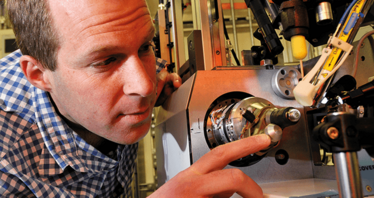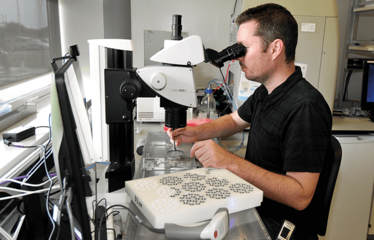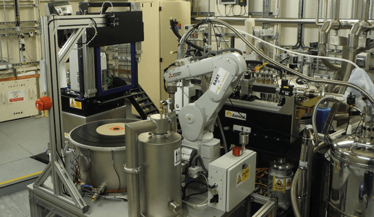
Fragment Screening at (Almost) the Speed of Light
The XChem facility offers drug discovery scientists streamlined, highly sensitive fragment screening, by harnessing the power of synchrotron light.
My vague awareness, as an undergraduate in my native South Africa, that structural analysis could help create new drugs, was given direction by the offer of PhD research with Tom Blundell, a world-leading figure in X-ray crystallography at Cambridge. However, it didn’t take long to notice that despite the tremendous power of X-ray crystallography, it was hamstrung by inefficiency. The questions I address now in high-throughput crystallography are often as much scientific as engineering challenges: how can we streamline processes and put the right infrastructure in place to fulfill the promise of the technique?
Currently, I have two roles. At Oxford University, I am part of the not-for-profit Structural Genomics Consortium (www.thesgc.org) – a public–private partnership that started off trying to facilitate compound development by solving structures of medically relevant proteins and placing them in the public domain, but has since moved to actively generating probe molecules. There, as head of the protein crystallography group, it’s my job to make sure that my colleagues can do the crystallization and X-ray experiments they need, as efficiently as possible – methodology is my research focus.
Three years ago, I also became head of a beamline at Diamond Light Source, the UK’s synchrotron facility, a few miles south of Oxford. For the uninitiated, a synchrotron is a particle accelerator, speeding up electrons to near-light speeds to generate very bright beams of X-ray, infrared or ultraviolet light. Each beam, up to 10 billion times brighter than our sun, is focused into an experimental station – the beamline. Beamlines around the world support a huge range of disciplines, but researchers in macromolecular crystallography have always been scientifically prominent users.

A bright idea
It had long been clear to me that structure-based “drug discovery” – compound development, really – was not living up to its promise; if it did, no chemist would start a structure–activity relationship (SAR) series without waiting for a crystal structure for a thorough computational analysis. Of course, that is not at all how it works in real life, for good reasons.
Yet, it took a while for the penny to drop that fragment screening was our best chance to change this. Fragment approaches are hardly new, and have become steadily more popular for lead discovery. Finding chemical fragments that may bind only weakly to the target, and combining them to produce a compound with useful affinity, requires a much smaller library than traditional high-throughput screening, and generates more hits, even for targets previously considered hard to drug.
The earliest fragment screening was carried out with X-ray crystallography but the process was slow and laborious, and soon fell out of favor. The biophysical techniques that replaced it are faster and cheaper, but are ambiguous when affinity is low, so hit verification became a major preoccupation in the field. Meanwhile, I’d seen first-hand how, within a decade, new technologies and algorithms have utterly transformed the X ray experiment at synchrotron beamlines, not only in terms of the sensitivity, but also speed and sample throughput.

Courtesy of Diamond Light Source
So when the job of principal beamline scientist came up at Diamond, the opportunity was too good to miss. I felt it was time to re-visit the idea of screening by X rays, but this time in a dedicated and publically accessible facility; it was clearly too complicated a process for every lab or company to reinvent the wheel.
I did worry that it was somewhat mad to run two groups with different remits, geographically separated, but looking back it was crucial to make the ambition a reality. I must credit my SGC colleague Paul Brennan, a medicinal chemist, for telling me to stop worrying and bite the bullet, as well as massive institutional support from both Diamond and Oxford. Above all, I was very lucky to have the full commitment of an extremely smart, talented double team, who came fully on board with the change in direction. It was their creative thinking that allowed us to cut though problems big and small; I may have come up with the idea, but they made it happen. The Diamond group focused on automating the beamline, building a soaking lab and worrying about how to make it a multi-user facility. The Oxford group contributed technologies and, crucially, carried out real experiments from very early on to discover what problems and bottlenecks we should focus on. A special mention goes to the SABS Centre for Doctoral Training – several of its consistently excellent students have made fundamental contributions.
The hard work has paid off. Five years ago it would be impressive to screen 200 compounds by crystallography in a few months; now, at the XChem facility, you can come and screen 1000 crystals in a week. Not only was there the beamline itself to adapt, whose power we had to harness by getting it to exchange and measure 100s of crystals in fully unattended mode. We also had to apply a range of new technologies, techniques and algorithms – some commercially available, some developed by us:
- Acoustic liquid dispensing – massively powerful in dispensing compounds into specific drops.
- Image identification – allows us to spot and cherry pick drops with crystals in them.
- Robot-assisted manual harvesting – speeds up by several orders of magnitude the mind-numbing chore of picking out hundreds of crystals; the record is now 200 crystals per hour.
- Algorithms to analyze the diffraction data – automatically zoom in on the outliers and extract the signal optimally. Much better than the alternative of gazing cross-eyed at a screen for five weeks.
None of these changes – or the many others we implemented – would necessarily be revolutionary on their own, but collectively they deliver a fast, streamlined process with low overheads for our users.
X(Chem) marks the spot
In 2015, we were able to open up the XChem facility to external scientists. We started with a trickle of projects back in April, before launching officially in November. The response has been fantastic from both academia and industry, and more than a dozen projects have now reached completion. All you have to do to apply is log into our website (www.diamond.ac.uk/Beamlines/Mx/Fragment-Screening) and write four paragraphs. You need to have a clear scientific plan and be working on a viable medicinal chemistry project, but it doesn’t necessarily have to be a drug discovery program – if you have an interesting idea and you have done your homework, our panel will consider it.
We’re now booked up for months in advance. We had faith that “if we build it, they will come,” and they have. It’s the first fragment screening facility of its kind, so the case studies of the internal projects we did early on with my group at Oxford have been invaluable, showing that even for challenging targets we were able to generate hits. That work helped to convince people that it wasn’t just an idea – we had tangible results.
The whole process typically takes a few days, spread across two visits to the facility. We give very close support to make sure everything runs smoothly. There is a dialogue ahead of time to make sure the user gets the right crystals and while they are here we take them through all the technology. In a year’s time it may be that experienced users can simply show up and do the experiment, but for now we offer a lot of scientific and technical support so that no previous experience is necessary.
So far, projects have mainly focused on enzymes and signaling molecules, and all have generated hits. For example, we ran a series of projects with the SGC sister site in Toronto, looking at a methyllysine-binding protein target involved in epigenetic regulation. Traditionally, no-one knows how to target these proteins and our Toronto colleagues had some leads but weren’t sure how to progress them. Their post doc Rachel Harding did a heroic 2500 datasets in just a few weeks, and went home with a series of new hits, several of them interesting leads for further chemistry.

Courtesy of Diamond Light Source
The future of fragments and a new bottleneck
On a wider scale, we believe that by making fragment screening more widely available, XChem will draw attention to bottlenecks further downstream. I can honestly say that I was never concerned about whether we could make XChem work. I was as confident as one can be that we could get the logistics and mechanics up and running – and that we would find hits. I knew we would have a great facility that could generate lots of useful data. I’m happy that the reality matches my optimism! What concerns me is what happens next.
Everyone agrees that fragments have a lot of potential, but the field seems to have focused more on validation than how to progress leads. That’s understandable to a degree – pursuing a hit is very expensive, so you want to be sure that your hit is real. But as David Rees at Astex Therapeutics has pointed out, the chemistry required for fragment-based drug discovery is quite different to that used in more traditional approaches (1). Right now, the repertoire of synthetic chemistry available is not wide enough to meet the needs of a fragment approach, and that needs to be addressed.
To me, speeding up synthesis is the biggest challenge facing the entire drug discovery community over the next five years. We have to make it much easier and much cheaper for anyone to generate potent compounds. If a PhD student discovers the structure of a new target, why shouldn’t they be able to generate potent compounds in a few months? What are we missing as a community? Why does it cost hundreds of thousands of pounds and take months and months of work by many, many chemists? For XChem, we have been able to speed up the process of finding hits – is there really no way that similar incremental fixes on the synthesis side can be made to expedite the next step? Paul Brennan’s “poised fragments” concept, which we published this year (2) is looking in this direction, but it is early days.
In the 80s and early 90s, it cost millions to sequence a gene, but then came high-throughput machines that could chug out base pairs by the billion and suddenly the human genome was within reach. We need that type of step-change transformation. Put bluntly, we have to confront the fact that synthesis is far too expensive. My hope is that in five years’ time we will be looking back and saying “I can’t believe how expensive it used to be”. The more hit-generation accelerates, the more acute the bottleneck becomes downstream. Diamond, as an organization, is keen to move the field forward, and to do that we need to break with current thinking and look to our imagination.
- CW Murray and DC Rees, “Opportunity knocks: organic chemistry for fragment-based drug discovery (FBDD)”, Angewandte Chemie, 55, 488–492 (2016).
- OB Cox et al, “A poised fragment library enables rapid synthetic expansion yielding the first reported inhibitors of PHIP(2), an atypical bromodomain”, Chemical Science, 7(3), 2322–2330 (2016).
Frank von Delft is a Principal Investigator of the Protein Crystallography group in the Structural Genomics Consortium at the University of Oxford, and Principal Beamline Scientist of beamline I04-1 at Diamond Light Source, UK.















